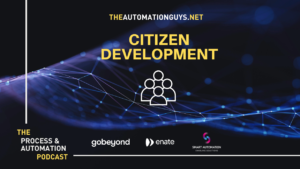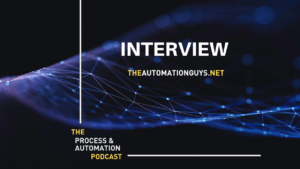Blog

How your business can benefit from AI Chatbots - PART 1
In this 2-part episode of the Process & Automation podcast you will find out how your business can benefit from AI chatbots, so you can become more efficient and to improve the customer experience.
Share This Post
Do you have any questions? Would you like to give us feedback? Are you interested in workshops on the topic of automation? Are you an expert in the field of automation and would like to be on the podcast?
LinkedIn Arno: https://bit.ly/3aABArd
LinkedIn Sascha: https://bit.ly/36Jd31T
Velocity-IT: https://www.velocity-it.com/about-us/
convedo Group: https://www.convedo.com/about-us
Episode Transcript
Business efficiency is a hot topic right now. And no matter what sector your organization is in, or what your specific business processes look like, there’s always room for improvement. In today’s episode of the process in automation podcast was the automation guys, you will find out how your business can benefit from AI chatbots so you can become more efficient, and to improve the customer experience.
Hello, and welcome to our first chatbot episode, and I’m sure there will be plenty of more. Today we will dive into the best use cases for external and internal facing AI powered chatbots. With me here, as usual, is honour to discuss today’s topic with me. Hello, Arno.
Hi, Sascha. So, why chatbots are now a hot topic? Well, chatbots and particularly those were that powered by AI or artificially intelligence and machine learning algorithms are, you know, gaining a lot of popularity, you know, across a lot of industries, you know, obviously, because of their power and their versatility. And, you know, their impact of these chat bots being deployed. And, you know, as they get adopted, from industry to industry, I thought it’s, it’s a really good time to dive deeper into, you know, what chat bots are? And how can I How can I help your business become more efficient. And I’m sure you know, as you know, our listeners out there know, you know, chat bots has been something that has been around for a while, but what we’ve seen in the last year or so is really these, these chat bots that’s powered by AI has become incredibly intelligent and be incredibly versatile. And you know, as it’s true for many sorts of mid to large scale organizations, and inevitably, on undoubtedly, you know, you have divisions in these organizations that face both output. So, this is to your customers or your clients. And then also divisions that faces inwards. And these are divisions that particularly handle, for example, employee concerns. So, I guess it doesn’t matter who the customer is of the chatbot. So outward or inward. And, you know, these chat bots can provide, you know, a lot of assistance in streamlining your processes and cutting processes costs, or process costs, you know, how much it costs to run these processes. And also helping people to get back to intuitive people centric, you know, aspects of their day-to-day roles within the organization.
Yeah, so it’s, it’s, it is a very popular topic, especially with the AI element of it. So I remember most of the airports, like with my online banking, if I have a question that pops up some sometimes with some websites, or nowadays, instead of the contact form, I think you see it as well. So you have this, sometimes very basic chatbots is more like, actually, its contact forms, but sort of it feels more conversational. But this is the year two, it’s very still very basic. In lots of cases. As you mentioned. Yeah. We talk about when we talk about chatbots, we talk about these, these two main areas external facing chatbots on the one side, and then the internal facing chatbots on the other side. So um, so let’s dive into the external facing one. So, the use cases ones first. So, yeah, so the external ones. Yeah, we are probably more familiar with, as I mentioned, we see we see this little icon there popping up in the right bottom corner, a lot. So better known. This kind of scenarios, like was the bank or so a very, very popular, and so be our shopping websites. So, we were more familiar with this one. So, we see it as well integrated, these reports integrated into sort of Facebook pages of companies. And yeah, so these are sort of typical sort of low hanging fruits for many businesses to be more customer facing. And yeah, so it’s like sometimes. Yeah, so just sort of, sort of a much-needed backup for x. Facing teams like customer service, for example.
Yeah, and I think Customer service is probably the first business area that people think about when they start using chatbots. And, you know, that’s a good reason. Because you know, customer service chatbots are becoming, you know, very popular. If you have incoming customer service request, you know, a lot of the simple queries can be handled by a chatbot, you know, before a human agent even sees them. So again, this, this frees up people to put a lot more time and energy into more complicated cases in their queue. So, you know, we can train a chatbot to, of course, pass the actual case, so to speak on to human agent need to do that, or that the human actually request for that to be done. And, you know, in all that this keeps customers very happy, because, you know, they’re getting a very good service. With the intelligence that’s behind these bots, I think people know, they talking to bots, but as long as it’s a service their request and provide them with a very seamless journey, then, you know, why not use this, I think, you know, it’s, again, that topic we touched on, you know, put the automation in the right place, for the particular degree of human interaction you need. So, if you have a sort of a tier one, sort of customer service request, a change of address, there’s no reason why you should speak to somebody on the phone to do that, you know, you can do that very quickly. Using a chatbot interface. Of course, there are security protocols, some of the chat bots we built. Before you actually get into the details of the chatbot, loading your door record or your file, or the data that you wish to update, it will send you a OTP code to your phone needs verify that. So of course, you know, they don’t all elements of security that needs to be considered. But these days, the chatbot platforms are so powerful. And of course, they’re all low code as well, you know, none of these chat bots needs to be coded by hand, it’s really just configuration, and all you need to determine is the sort of journeys that you want to enable these chatbots to take your customers on. And for customer experience, I think that’s the number one-use case, and probably the lowest hanging fruit for chat.
Especially with a really good design to chatbots on your website, you can really cover a cover all the customer needs 24 seven, isn’t it so your main office hours are maybe from nine to five. I think there’s lots of insurances and banks, that’s the case. But lots of things actually happening when people are back from work now with home offices and work, you’re working from home is a bit different maybe. But very often it is the case you Only you have when it comes to online banking, or that kind of stuff, it only all happens usually in the evening hours. And if you don’t have a really good chatbot in place, that that is very rarely very beneficial for the end customer. Especially if like things like claims or whatever I immediately processed through. It’s fantastic.
And it’s a differentiator i think that you know, what, where do I want to go to get my queries resolved a place where I can quickly speak online? 24, seven, whenever it’s convenient for me to a mechanism or something that could resolve my query very fast, very interactive? Or do I want to go to a place where after phone number end up in a queue, speaking to various people just to do a very simple customer service request. So again, I think that’s becoming a really good differentiator, you know, for businesses out there. You know, and this is not a nice to have, I think, sort of going into 2022 I think this is an absolute must for business and wants to, you know, promote good, good customer services, for example, and create good customer experience. Now, of course, you know, it doesn’t end with chatbots. You know, chat bots are just a channel but it’s a very popular, convenient channel. And very known because a lot of people, of course, are using peer to peer messaging. So it’s a very familiar experience. And I think as long as the automation behind the chatbot, like the robotic process automation, that the chatbot leverages to go and actually fetch that cost Record from your back. And as long as all of those things are also plumbed into the design of the bots, you can create really really superior experiences for your customer. Which is, you know, real time, I mean, I saw an example of a chatbot. And I know, they say you shouldn’t humanize it too much. But in this instance, when the customer record was loaded, and it was also the customer’s birthday, it did say, in a friendly way with emoji, happy birthday, and it’s the small things like this, that kind of quote, unquote, know your customer that actually makes these things actually more approachable. You know, make them more, sort of, except acceptable to us, you know, not just for millennials out there, and that’s kind of on their phones all the time, kind of chatting away to to each other, but also, you know, other generation of people as well, which would traditionally would have picked up the phone. So, it’s, it’s, it’s such a powerful, powerful tool that you round off your hyper automation, journey worth. And that, you know, again, I would say to all our listeners out there that that kind of, is interested in this topic, I think, in 2022, and beyond that, this will become something really, really big.
It seems like, pops up already on most, most websites, and the very basic version. So this kind of stuff, sort of commoditize is at the moment, so everyone is getting really, really used to the to the first level, but really combining it with was the AI or not even necessarily the AI but with all the data, I think this is where, where then yeah, the next level really can, can be very, very powerful for businesses, connecting, you know, we have this last week as well. So, there’s so much data out there, just you just need to connect it. And putting all that stuff now and into the customer channel is extremely valuable.
Yep,and making it and I think know your customer, you know that that’s such a golden mantra, take forward in your automation journey, you know, I think that should be the slogan that should be, you know, very prominent on your agenda. Because I think that once you, once your customer knows that you know them well and what they want and their preferences are, then that that’s a very, very good foundation to lay a very powerful customer service journey for your customer. And also the retention of your customers, you know, you want to keep them you want to make them feel like they’re at a place where you do care, you do know about them, you do resolve queries very quickly. Do I want to go somewhere else? No, because I like these guys. And again, you know, I think more about let’s look at products and services, that prices of products and services, I think people sometimes because they’re so busy these days, they are willing to sacrifice a higher price point for a better service and a better service. And I think this is the enabler for that.
And especially in difficult times crisis time, so I think every business should focus on really keeping the customers and, and making that sales process and customer process as easy as possible. Because winning a new customer. I think if someone is not really happy with maybe worse, a very slow, manual customer service, losing the customer can be quite expensive, or winning a new one is usually Far, far more expensive. So I think it’s very wise for business to adopt that to bring that in, especially now we all sort of 100% more digital, then then we have been last year. So I think that that needs to be spot on. And then that brings us to the next point, I think the order processing is another really good use case for chatbots. So we talked about this new your website, and maybe that website has a few hiccups and maybe within processing something goes wrong. And so and then you might lose the lose the order and you get frustrated. But if there’s immediately sort of a chatbot available for you on the site to maybe ask that question or what happened here. I was halfway through the order. And the job board understands that and can then use the API connections and co create sort of that capability into sort of back-end systems and you Your order systems, inventory systems, payment systems, customer records. So, if this is all available for the chatbot, so then then you can really have the customer keep that engaged and say, are we sorting this out, and we found the order, so that that’s so much easier. And, yeah, so as soon as we have something like that in place for our customers, with all the sort of service requirements, the chatbot can handle all these, these things. And as you mentioned, this one was the birthday in between, at the same time, a chatbot can be can do very, very clever upselling, as well. So, a lot of this, this, this, this technical equipment here usually was it was this technique where we sort of suggest these accessories. So why not putting them on the order? So, all these kinds of things? Yeah, really make a difference.
And I think the art of the impossible is very, very short, small year. You know, the, the possibilities using this is, is vast, and you’re talking about upselling. And I think that, you know, let’s face it, everybody loves a bargain.
And, you know, in my head, I can imagine a journey where I am actually interacting with a shopping cart, are there certain things that I want to purchase? You know, maybe recommendation is made to purchase another add on? If I say no, then actually you can train this chat bot to negotiate and say, well, I’ll give him what about a 10% discount, or a 20% discount. So, these are the things that’s the reality, these are the things you can build. And I think it’s important to mention to our listeners out there. And when we say chatbot, we do not just mean one digital bot that sits there, these things scale. So, you could have absolute army of these things that is extremely scalable, that could do 1000s of concurrent engagements. You know, and like you said, with order processing, you know that that’s a simple example. But with that scalability that’s built in into technology, the reach, you know, to do some of these additional selling or additional offers for end customers are massive. And you know, and that have a very, very big impact. You know, on your business’s bottom line, for example, if, if you, for instance, to online selling, for example.
Yeah, I think, and there’s a really, really good point you made there, I think there’s so many use cases, and some of them, if it’s come to upselling. If you think about the costs of a chatbot, for example, in putting this in place, so the costs are obviously, there are some costs, but they’re very, very, yeah, it’s not as crazy as you might think. But having those kind of use cases in place where you automatically upsell or generate 30 40% more business per sale. So, this immediately pays off for pay space for this kind of implementation. Plus, it has all sorts of other benefits, not just on the upselling side. But very often these technologies like RPA, the return of investment, the ROI is very, very early achieved. And this this certainly applies here as well.
But I think about the journey as well. So, I am placing an order. And I am not just getting very good service and guidance throughout the order of back myself back. And but it doesn’t have to stop there. Because the engagement with a chatbot can also be asynchronous. And what you know what that means is that once your order is dispatched, the chatbot will actually engage you again and say, you know, we’re excited to tell you your order is now being dispatched. And it will be delivered with you on this date. And then once the order is delivered, you know, it will actually tell you that it’s been delivered, you know, enjoy your product. And so it’s not, it’s not just that kind of initial touch point with the customer. And then once the order goes down, the chatbot disappears. It’s also just following through that whole journey. Just to, I guess, give gift, give the customer really, really good experience, up until the goods arrive. And again, you know, the chatbot is something that could practically send out a ping as well, to notify you and, and you can, you can, you can talk back to it. And, and, you know, request, perhaps the delivery date being changed, for example, we can offer you a set of delivery dates, that allows you to choose one that’s convenient for you. So again, the use cases for this is so broad. And really, it’s so powerful, if you think about it are all of these different types of experiences you can create?
Yeah, this is why we probably not have just this one episode on chatbots, there will be plenty more. Because the interest is really increasing as well for all of our customers. So, we get plenty of inquiries in because yeah, becomes the next big thing really was for many enterprises already, but for most business is currently. Yeah, really, really cool. Cool stuff to adopt. So yeah, so the next one, we have here, see use case, supporting your employees who technical staff was sort of technical support, and you probably know him. So most, most of the technical problems are, can be resolved by switching on the on and off the computer to get is working. Actually, that’s very true had a situation last week, where I couldn’t believe it about over just switching it on, off and on, actually solve the problem. So that’s so indeed, a very, very good use case for your technical staff. If they just know what to do sometimes it’s very simple, sometimes it’s quite complex, but if your technical staff if technicians out in the field can actually communicate with was the chatbot and receive instructions. So, then it can be can you can resolve problems are very, very easy. And sometimes these things can be automated, they can be then passed on to other systems to do stuff automatically. But you can chat was the board, sometimes you get instructions, sometimes you can even do the reboot in the in the back end to solve these problems. And, yeah, and then furthermore, yeah, for example, if it’s a broadband problem, or so and you’re talking to a chap, or maybe that chap or can do something in your router automatically, if it has the right way of doing things, the right permissions of doing things. But this is really, really good. And then this only leaves What do you mentioned earlier, you can free up people, again, your staff again, on to really concentrate on the only really complicated issues. So what the majority can be potentially done by the board, or the helping your technicians or other people, or customers, solving the technical problems themselves with instructions, or even go deeper into the infrastructure in the back end.
Yeah, I guess, you know, we talk about putting the right automation in front of the audience that would engage with it. And you know, I think a lot of sort of technical support issues, especially tier one issues can be resolved by just leading a person and coaching them how to do things like you know, turn the computer off, turn it on, of course, you’re on your mobile phone when you chat with the chatbot. So, it’s really convenient. All the chat bot asked him a few questions. And again, you know, the sort of higher tier two and three issues. These are the ones that we want to route to a human because they are perhaps more the complicated ones, which neither.
Unfortunately, that’s it again, was this episode of the process in automation podcast. If you liked this episode, please give us a five-star rating. And do not forget to subscribe to this podcast, so you don’t miss any upcoming episode. We hope you will tune in next time and until then, let’s automate!
- April 13, 2021
- 8:58 pm


